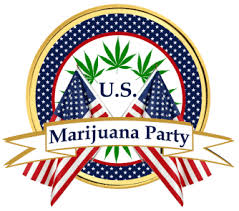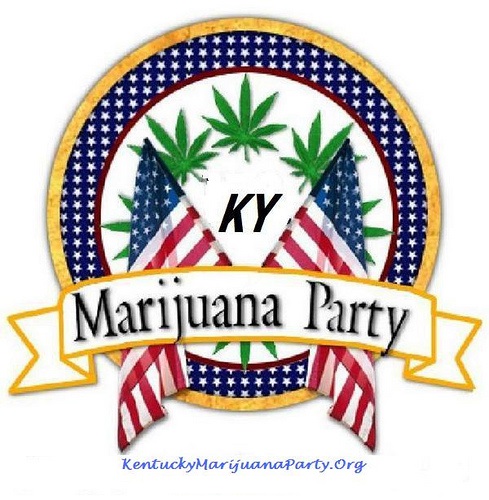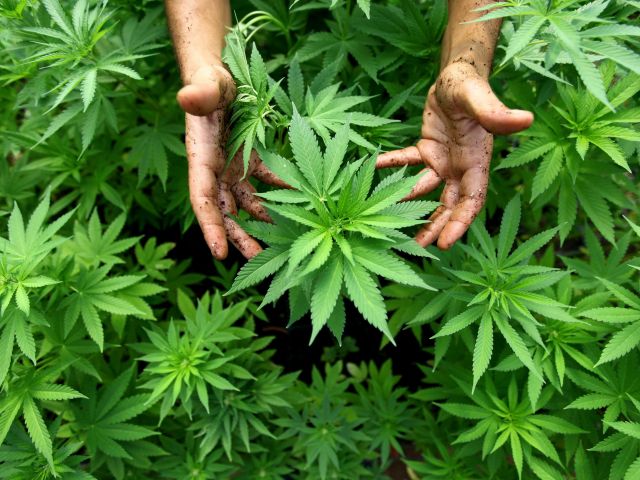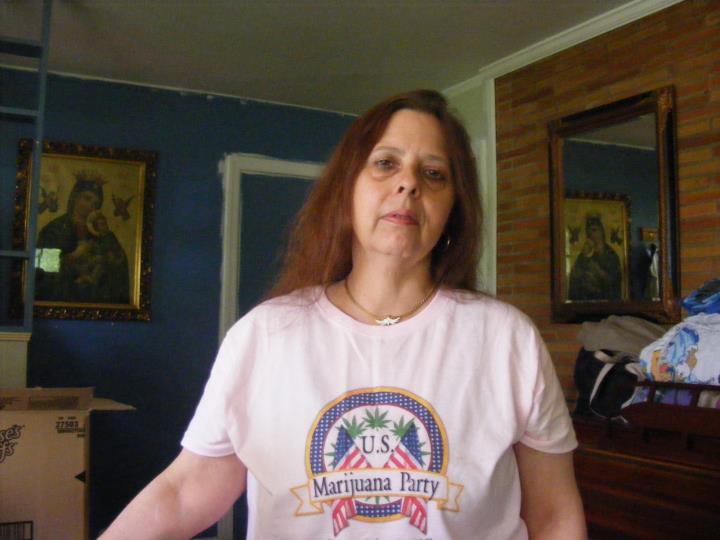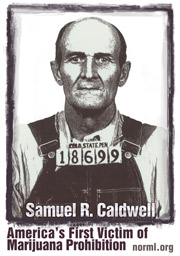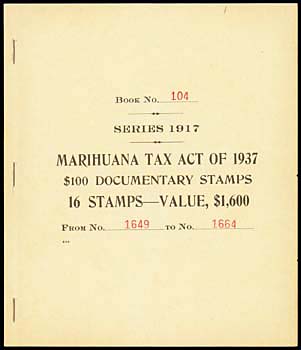PLEASE HELP RONNIE SMITH'S FAMILY!
Brian McCullough via Renee Gibson
Ronnie's sister here. He sent me a message today and I spoke with him a bit ago. It seems that the Dr's. are giving him 2 weeks to live. He said he will be going home with hospice in a couple days. He is still hoping that the oil will help but is sad also. I have created a gofundme page to help me and his son get from KY to CO to be with him. If anyone can help us out it would be much appreciated.
HERE IS THE LINK TO DONATE!
http://www.gofundme.com/7orqn4
HIS FACEBOOK PAGE IS HERE. PLEASE SEND LOVE AND PRAYERS!

Brian McCullough For the love of God..., please share this far and wide.On group pages and such...
I have to get off line and wont be back till Monday. I want his friends and ours to send healing energy to my buddy.
I can only hope you all will get this message before it's too late.
Peace out, Brian
Brian McCullough via Renee Gibson
The Origins of California's 1913 Cannabis Law
by Dale H. Gieringer
Summary of "The Forgotten Origins of Cannabis Prohibition in California"
Revised May 2012 - original version published in Journal of Contemporary Drug Problems, Summer 1999 26(2): 237-288.
Although marijuana prohibition is commonly supposed to have begun with the Marihuana Tax Act of 1937, cannabis had already been outlawed by California in 1913, during the first, Progressive Era wave of anti-narcotics legislation.
The 1913 law received no public notice in the press, but was passed as an obscure technical amendment by the State Board of Pharmacy, which was then leading one of the nation's earliest and most aggressive anti-narcotics campaigns. Inspired by anti-Chinese sentiment, California was a nationally recognized pioneer in the war on drugs. In 1875, it instituted the first known anti-narcotics law in the U.S., a San Francisco ordinance against opium dens. By 1907, seven years before the US Congress restricted sale of narcotics by enacting the Harrison Act, the Board of Pharmacy had engineered an amendment to California's poison laws so as to prohibit the sale of opium, morphine and cocaine except by a doctor's prescription. The Board followed up with an aggressive enforcement campaign, in which it pioneered many of the modern techniques of drug enforcement, including undercover agents and informants, criminalization of users, and anti-paraphernalia laws, climaxed by a series of well-publicized raids on pharmacists and Chinese opium dens.
During this time, cannabis was never an issue, its use as an intoxicant being largely unknown in California. "Marihuana" the Mexican name for the drug, was scarcely heard of before 1910. Instead, it was known as hashish or Indian hemp, an exotic vice of Asiatic foreigners and a handful of bohemians. Although cannabis was grown for hemp in the Central Valley and occasionally used in medicine, California newspapers of the early 1900s are silent on hashish and marijuana. In 1909, the police department of San Francisco reported, "there has been only one case of the use of Indian hemp or hasheesh treated in the Emergency Hospitals in six years, and that was accidental" (presumably an overdose). 
Nevertheless, Indian hemp had come to the attention of the narcotics authorities, in particular Hamilton Wright, the chief architect of U.S. narcotics policy, and Henry J. Finger, a prominent member of the California Board of Pharmacy who had been appointed with Wright to the U.S. delegation to the first International Opium Conference at the Hague in 1911.
Wright, a brash and enthusiastic drug prohibitionist, had been pushing to have cannabis included in federal drug legislation. "I would not be at all surprised if, when we get rid of the opium danger, the chloral peril and the other now known drug evils, we shall encounter new ones," he wrote. "Hasheesh, of which we know very little in this country, will doubtless be adopted by many of the unfortunates if they can get it."
Finger, a forceful proponent of aggressive enforcement in California, had similar ideas. In a remarkable letter to Wright, dated July 2, 1911, he urged that the Conference take up the cannabis issue:
"Within the last year we in California have been getting a large influx of Hindoos and they have in turn started quite a demand for cannabis indica; they are a very undesirable lot and the habit is growing in California very fast...the fear is now that they are initiating our whites into this habit... We were not aware of the extent of this vice at the time our legislature was in session and did not have our laws amended to cover this matter, and now have no legislative session for two years (January, 1913). This matter has been brought to my attention a great number of time[s] in the last two months...it seems to be a real question that now confronts us: can we do anything in the Hague that might assist in curbing this matter?"
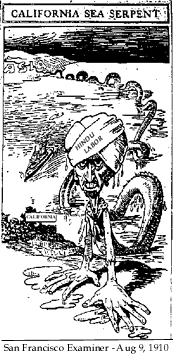
The "Hindoos," actually East Indian immigrant of Sikh religion and Punjabi origin, had become a popular target of anti-immigrant sentiment after several boatloads arrived in San Francisco in 1910. Their arrival sparked an uproar of protest from Asian exclusionists, who pronounced them to be even more unfit for American civilization than the Chinese. Their influx was promptly stanched by immigration authorities, leaving little more than 2,000 in the state, mostly in agricultural areas of the Central Valley. The Hindoos were widely denounced for their outlandish customs, dirty clothes, strange food, suspect morals, and especially their propensity to work for low wages. Aside from Finger, however, no one complained about their use of cannabis. To the contrary, their defenders portrayed them as hard-working and sober. "The taking of drugs as a habit scarcely exists among them," wrote one observer.
Nonetheless, Finger's concerns were sympathetically received by Wright, who replied, "You certainly should have your legislature do something in regard to Indian hemp." Wright's effort to include cannabis in federal drug legislation would later be foiled by the pharmaceutical industry, which objected to the inclusion of a seemingly innocuous patent medicine ingredient. However, the wheels for prohibition were set in motion in California, where legislation to ban "narcotic preparations of hemp" was introduced in the 1913 legislature.
By this time, another menace had appeared on the horizon: "marihuana" had begun to penetrate north of the border from Mexico, carried by immigrants and soldiers during the revolutionary disorders of 1910 - 1920. Though hardly known to the American public, marihuana or "loco-weed" was noticed by the pharmacy journals, which surmised that it was a relative of Indian hemp or perhaps jimsonweed. In Mexico its use was mainly associated with delinquents and soldiers, lending it a discreditable reputation for madness and violence. With this in mind, the Board duly added "loco-weed" to its 1913 legislation.
The 1913 Poison Act Amendments
The 1913 bill passed with no public debate. Unlike previous narcotics bills, it was opposed by the state's druggists, who had voted against further changes in the poison laws in a poll of their membership. However, the Board was in good control of the legislature, which passed it unanimously.
The new law, which took effect on August 10, 1913, was accidentally misworded. Instead of adding cannabis to Section 8 of the Poison Act restricting the sale of opium, cocaine and other narcotics, it took the curious form of an amendment to Section 8(a) banning the possession of opium paraphernalia. In specific, it outlawed the possession of "extracts, tinctures, or other narcotic preparations of hemp, or loco-weed, their preparations or compounds (except corn remedies containing not more than fifteen grains of the extract or fluid extract of hemp to the ounce, mixed with not less than five times its weight of salicylic acid combined with collodion)." An unfortunate implication of this language was to ban all medical uses of hemp drugs - except for corn remedies, which were exempted because they had negligible potency and were a popular, if medically dubious, application by proprietary drug manufacturers.
In practice, there is no evidence that the law was ever used or meant to restrict medical use of cannabis. Rather, it appears to have been misworded as the result of a legislative blunder, having been originally written as an amendment to Section 8, which allowed for possession upon prescription, then carelessly moved to Section 8(a), which did not. The move was probably made because Indian hemp, unlike cocaine and opiates, was not typically purchased from pharmacies but grown in the fields by Mexicans and "Hindoos." This being so, it might have seemed reasonable to spare pharmacists the regulatory burden of restricting pharmaceutical sales and instead to simply ban possession by users as with opium paraphernalia.
In fact though, pharmaceutical cannabis was occasionally sold to recreational users, according to testimony by pharmacists to the U.S. Department of Agriculture Bureau of Chemistry in investigations of hemp drug traffic along the Mexican border.
This loophole was patched up in 1915, when the legislature amended the Poison Act to include cannabis in Section 8 alongside opium and cocaine, explicitly forbidding the sale of "flowering tops and leaves, extracts, tinctures and other narcotic preparations of hemp" except on prescription. Though Section 8 permitted the possession of legally prescribed narcotics, the possession of hemp drugs (other than corn cures) remained independently outlawed under the 1913 paraphernalia provision, which remained on the books until 1937.
In later years, the 1915 law was incorrectly recorded as the state's first anti-cannabis law. This confusion, like the negligent miswording of the 1913 law, is evidence of the very obscurity of the cannabis issue. The fact is that cannabis was a regulatory issue of little concern to anyone except the Board. In the end, Finger's cannabis-using Hindoos were merely a handy excuse for the Board to work its will. In the climate of the times, no more excuse was needed. Bolstered by Progressive Era faith in big government, the 1910s marked a high tide of prohibitionist sentiment in America. In 1914 and 1916, alcohol prohibition initiatives would make the state ballot. Meanwhile, the legislature was tackling such morals issues as prostitution, racetrack gambling, prizefighting, liquor, and oral sex. Amidst this profusion of vices, Indian hemp was but a minor afterthought.
THE ADVENT OF MARIJUANA
Although passage of the law attracted no notice, the Board's enforcement efforts soon brought marijuana to public attention as its agents launched a crackdown in the Mexican Sonoratown neighborhood of Los Angeles in 1914. In what may be the first marihuana cultivation bust in the U.S., the Los Angeles Times reported that two "dream gardens" containing $500 worth of Indian hemp or "marahuana" had been eradicated (Sep. 10, 1914). According to police, the drug was surrounded by sinister legends of murder, suicide and disaster. After the initial crackdown, interest in marihuana subsided; not until the 1920s was its use noted in Northern California.
Other states banned cannabis in the 1910s: Massachusetts in 1911; Maine, Wyoming and Indiana in 1913; New York City in 1914; Utah and Vermont in 1915; Colorado and Nevada in 1917. As in California, these laws were passed not due to any widespread use or concern about cannabis, but as regulatory initiatives to discourage future use. The first true marijuana scare in the country occurred in El Paso, Texas, on New Year's day 1913, when a Mexican bandido, allegedly crazed by habitual marijuana use, shot up the town and killed a policeman, prompting the city to ban marijuana two years later.
Ironically, it was only after marijuana had been outlawed that it began to become popular. Although attitudes against drugs hardened with the enactment of alcohol Prohibition, marijuana became increasingly common in the 1920s. By 1925, it accounted for one-quarter of drug arrests in Los Angeles and 4% of those in San Francisco. By this time, penalties had been increased: possession and sale, which had initially been misdemeanors, became punishable by up to six years in prison. Despite this, usage spread inexorably. By 1930, marijuana accounted for nearly 60% of drug arrests in Los Angeles, and 26% statewide, at a time when there were 878 total drug arrests in the state. After taking a backseat to the Depression and World War II, usage resurged in the 1950s. Once again penalties were hiked, to a minimum 1-10 years for possession. Nonetheless, arrests continued to mount, reaching 5,155 in 1960. After that, usage exploded to epidemic proportions during the counterculture revolution. By 1974, California staggered under a record 103,097 marijuana arrests, virtually all of them felonies. Overburdened by the costs of enforcement, the legislature decriminalized marijuana possession with the Moscone Act in 1976. Arrests promptly plummeted by 50%; in recent years, they have continued at an average level of 18,000 felonies and 34,000 misdemeanors per year.
In retrospect, the legacy of California's cannabis ban is one of dismal failure. The entirety of the modern "marijuana problem" occurred after cannabis was prohibited. From the time that it was first banned in 1913 to date, the number of marijuana users in California has increased from a handful to several millions, while the number of persons arrested for cannabis offenses has totaled over 1,850,000. Historically, it seems significant that California, which was one of the first states to outlaw cannabis, was one of the first to decriminalize it as well as the first to re-legalize its medical use in 1996. After 87 years of failure, the time appears ripe for new directions in the 21st century.
November, 1999
